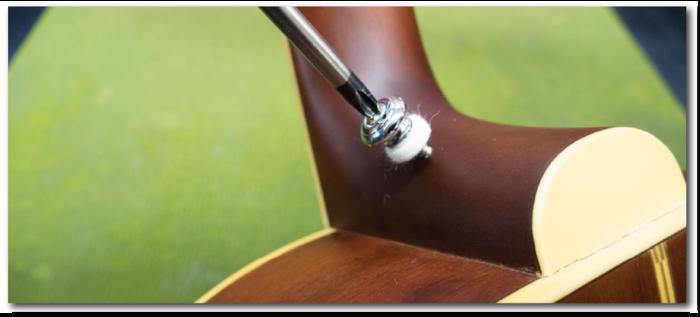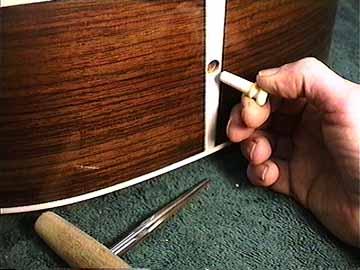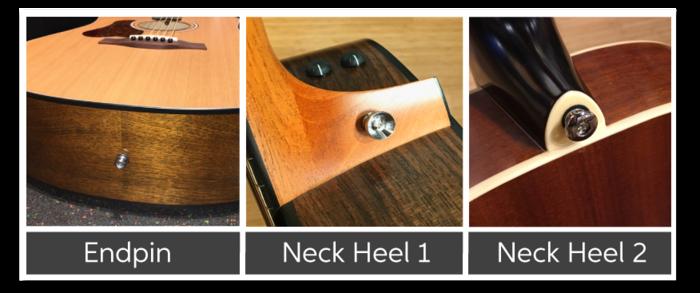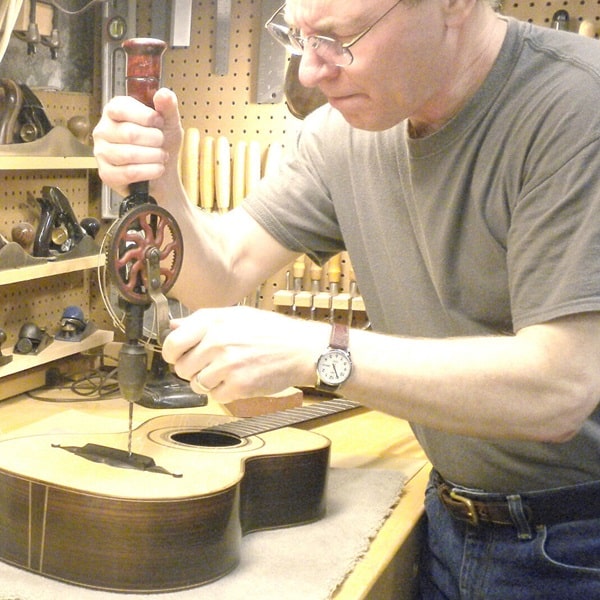Imagine being onstage, in the middle of a guitar solo, when suddenly, your instrument slips out of your grip, held merely by the fretting hand. The culprit – a failed guitar strap button. Unfortunate incidents like these underscore the importance of this often overlooked guitar accessory. Believe it or not, this was just another day in my life back when I began my career in lutherie in 1994.
In the ensuing years, I’ve seen firsthand the evolution and significance of every nut, bolt and accessory that make up this beautiful instrument we call the guitar. Today, it’s my hope to enlighten fellow guitar enthusiasts and musicians alike on the necessity of a sturdy guitar strap button.
It may seem like a small, insignificant piece of your guitar- an afterthought compared to the wood type, the pickups, or strings. But having delved into the enthralling world of lutherie, I can’t stress enough how vital guitar accessories can be, particularly the guitar strap button.
The role of a strap button transcends aesthetics. It’s not just about good looks, but establishing a harmonious relationship between the passionate musician and the loyal instrument. It’s about providing stability during those stage antics and ensuring comfort while playing lengthy gigs. From a practical standpoint, who could ignore the blatant convenience the strap button and its installation bring to the table?
Armed with the knowledge I’ve accumulated over decades in the business, I will navigate you through the nuances of guitar strap button installation and selection. Strap in, guitar heroes, this ride is going to be enlightening.
Guitar Strap Button: What and Why
Importance of Guitar Strap Button

Throughout my musical career, the frequently unappreciated guitar strap button has proven vital to both the convenience and safety of my performance. I’ve had numerous instances on stage where a secure strap button was the unsung hero that saved the day. Reflecting on my years of experience, one cannot overstate the importance of a properly positioned and secure strap button.
First and foremost, a well-adjusted guitar strap button is essential in securing the guitar strap. A loose or poorly placed button can lead to the strap slipping off, potentially causing damage to the guitar or even disrupting a performance. I recall a particular gig where, thanks to my dependable strap button, I avoided a near catastrophe of my guitar slipping off mid-song.
Guitar strap buttons also provide necessary stability while playing, specifically when standing. A meticulously mounted strap button balances the guitar correctly on your body, permitting a comfortable and efficient playing
position. I have personally found that the correctly positioned strap button significantly enhances the ease of maneuvering my guitar on stage, effectively boosting my performance.
In terms of safety, investing in good quality guitar strap locks cannot be overemphasized. Strap locks, which attach to the strap buttons, offer a supplementary layer of security, preventing the strap from unintentionally disconnecting. I can’t count the number of times these guitar strap locks have saved my guitar – and my act – from potential disasters.
Subsequent to detailing these reasons, I fundamentally advocate for the attention, care, and consideration every guitarist both beginner and veteran alike, should invest when it comes to guitar strap button installation. In my first-hand experience, appreciating the minor details can make a significant difference.
In the next section, we will explore the optimal location for installing a strap button, rounding out your understanding on this critical, yet often overlooked component of guitar setup.
Where to Install the Strap Button
End Pin Installation Guidelines

After delving into the significance and deciding upon the optimal position for your strap button, it’s crucial to grapple with the specifics of end pin installation. As an essential part of attaching a strap to your acoustic guitar, the correct installment of the end pin cannot be skirted around.
In my extensive experience and research, I’ve experimented with various methods for end pin installation, invariably honing a deep understanding of the process’s intricacies. I aim to share this knowledge, aiming to ensure a faultless installation process for enthusiasts and novices alike.
Primarily, the end pin should be firmly secured into the tail block of your acoustic guitar. Note that it is additional to the strap button and essentially serves as a terminal point for the strap. Care should be taken while drilling the pilot hole for the end pin; it should be slightly smaller than the end pin’s diameter to guarantee a snug fit.
Remember, the role of the end pin is not purely aesthetic; it serves a vital functional purpose. Therefore, its precise installation is undoubtedly a prerequisite for a seamless guitar strap application and, consequently, a hiccup-free musical experience.
Moving forward, we will delve into the step-by-step guide on how to correctly install a strap button on your guitar, incorporating the subtleties and nuances learned from the best practices for end pin installation. By understanding these key aspects, you can bypass common mistakes and potently improve the overall functionality and comfort of your instrument’s strap.
How to Install a Guitar Strap Button
Step-by-Step Guide to Installation

In guiding you through the process of installing a guitar strap button, I am drawing from the depth of my expertise and countless practical experiences. It is the application of these years of handling stringed instruments and constant admiration for guitar modification that empowers this process.
Step 1: Determine where to place the strap button. This is crucial as its positioning can affect the guitar’s balance. Typically, it’s placed on the heel of the guitar’s neck, but the exact spot can depend on your personal preference or the guitar’s construction.
Step 2: Mark the spot with a pencil. This precision can ensure you drill the hole in the correct location, avoiding unnecessary damage to your guitar.
Step 3: Prepare to drill the hole. For this, you need a drill bit that’s slightly smaller than the screw you’ll use to secure the button. This creates a snug fit, preventing the button from loosening.
Step 4: Drill the hole to the correct depth – not too deep, not too shallow. Here’s where an in-depth understanding of guitar anatomy can come in handy.
Step 5: Align the button with the hole and secure it using a screw. Don’t force the screw in – it should fit comfortably, not damaging the wood.
Step 6: Attach the guitar strap. Make sure it fits securely with no chance of slipping. This is how to attach a guitar strap correctly, a crucial step in ensuring your guitar’s safety and your comfort while playing.
Thoroughly understanding each step and performing it with care significantly enhances the life and functionality of your guitar. While we’ve focused on ‘how’, remember that the ‘why’ can be just as important – a well-installed guitar strap button provides stability, enhances playability, and protects your instrument from accidental falls.
Remember, every guitar modification should be done thoughtfully. Bear in mind that the process outlined here should be repeated on the other end of the guitar, where most guitars already have an end pin installed. The steps, however, remain more or less the same.
In the following section, we’ll divulget into the world of guitar strap selections to ensure that you choose the right strap button for your beloved instrument. Each decision you make reflects not only on the instrument’s performance but also on your own, so choose wisely.
Choosing the Right Strap Button

I’ve made a significant commitment throughout my musical journey to exploring the realm of guitar accessories, particularly strap buttons. Having played multiple shows, from small bar performances to larger concert stages, I realize how crucial the right strap button is for comfort during performance and, most importantly, the safety of my prized guitars. My journey has enabled me to get my hands on many guitar strap buttons for sale, experiment with different types, evaluate their capacities, and draw conclusions on what works and what doesn’t.
Baffled by the variety of strap buttons available in the market? Let’s simplify, as we explore what makes a strap button perfect for your needs.
Initially, the variety was overwhelming. The market offered strap buttons in different shapes, sizes, materials, with some promising better grip, while others boasted of easy installation. However, I have learned that the best strap buttons are often those that take into account the specific nuances of both the guitar and the player. This not only impacts the comfort and ease of playing but also affects the sound quality and safety of the instrument. Through experience, I’ve gathered that it’s not just about the make and material, but the comfort and security it provides.
Among the numerous products tested, I consistently find myself leaning towards strap locks. These special buttons come with a mechanism that locks the strap in place, providing a sturdier hold than regular buttons. Besides, the best guitar strap locks I’ve tried ensured total security of my guitar, regardless of how much I moved or swayed during my performances.
They not only provided peace of mind but also gave me the freedom to truly immerse myself in the performing experience, without constantly having to worry about my guitar taking a disastrous fall. Their make, typically metal, not only promised durability but also assuaged my concerns about the strap slipping off mid-performance.
Yet, let me also emphasize that choosing the right strap button is a highly personalized endeavour. While my preference leans toward strap locks because of my stage performance needs, your choice may vastly differ if you’re more of a relaxed armchair player or a studio recording artist. The crucial factor to keep in mind while making a choice, remains that the strap button must ensure your guitar’s safety and enhance your playing experience, rather than impede it.
Before wrapping up, let me suggest that no matter your choice, ensure the strap button’s proper installation. A poorly mounted strap button, no matter how expensive or acclaimed, will yield little utility and could potentially damage your guitar. Follow the step-by-step guide provided in an earlier section of the article for this purpose.
So, amidst all the guitar strap buttons for sale, invest some thought into selecting something that fits your playing style, guitar type, and personal comfort factors. Remember, the smallest of components can have a substantial impact on your much-loved musical journey.
FAQs
What Is a Guitar Strap Button?
How to Choose the Right Strap Button for Your Guitar?
How to Install a Guitar Strap Button?
What to Do If a Strap Button Comes Loose?
Conclusion
Feeling confident about installing a guitar strap button now? Let’s conclude this enlightening journey together. Over the course of our guide, we’ve delved into the depths of everything related to guitar strap button installation, dissecting the what, when, where, why, how, and who to furnish a complete and nuanced understanding.
We began by exploring the concept and importance of guitar strap pins. These tiny components play a crucial role in not only securing your guitar strap but also ensuring that you can comfortably and confidently perform. We then delved into the specifics of where to install the strap buttons, timing the installation, and the essential guidelines for end pin installation. If you follow these carefully and meticulously, installing your guitar strap button will be a breeze!
A step-by-step guide to installation followed next, with each step broken down into manageable, understandable segments. Whether you’re a pro player or a beginner, consistent practice and implementation of these steps will help ensure a successful guitar strap button installation. We wrapped up with strategies to choose the right strap button and some frequent queries, helping clear up any remaining uncertainties and empowering you with the knowledge to make informed decisions about your equipment.
Through this comprehensive guide, my goal was to blend personal experience with deep-rooted expertise, helping you perfect your guitar and enhance your playing experience. The journey of music and lutherie is indeed lifelong, and every step you take towards better understanding and maintaining your instrument reinforces your bond with it. A well-installed guitar strap button is just one of many steps you’ll take in this journey, but it’s a vital and fulfilling one.
With the knowledge you’ve gained, I hope you feel a renewed sense of connection with your instrument, understanding it a little better than before. Enjoy this newfound confidence and let it show in your music. Until the next guide, happy strumming!

R.M. Mottola, an engineer-turned-luthier, revolutionizes stringed instrument design with his deep focus on acoustics and ergonomics since 1994. As editor of the Savart Journal and a key contributor to American Lutherie, Mottola merges science with artistry in lutherie. He enriches the field with his extensive knowledge, shared through his Liutaio Mottola website, making him a beacon in the world of modern instrument craftsmanship.
